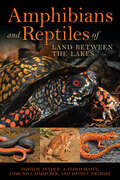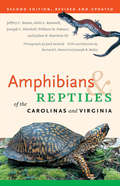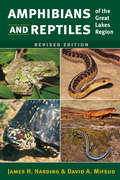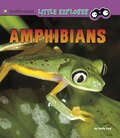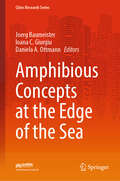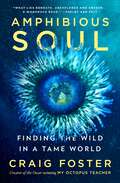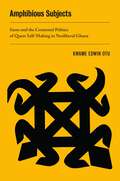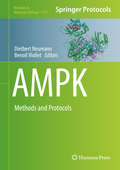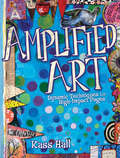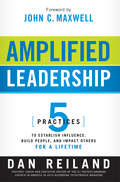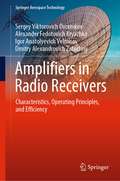- Table View
- List View
Amphibians and Reptiles of La Selva, Costa Rica, and the Caribbean Slope: A Comprehensive Guide
by Dr. Craig Guyer Dr. Maureen A. DonnellyThis field guide at last provides an authoritative and handy source for identifying amphibians and reptiles of Costa Rica's renowned Atlantic lowland tropical forests. Colorful frogs, lizards that can run across water, snapping turtles, spotted geckos, boa constrictors, crocodiles, and many other fascinating yet secretive species of amphibians and reptiles flourish in the region's myriad microhabitats. The La Selva Biological Station, a protected reserve, boasts a rich biota, making it and the surrounding area one of the most visited tropical forest sites in the world. For travelers, ecotourists, and biologists, this comprehensive guide, written by two distinguished experts on the area's amphibians and reptiles, will be an essential resource while visiting La Selva and the surrounding tropical forests of Costa Rica. In addition to providing reliable field identification, it will help visitors to this area better understand the overall role of Central American amphibians and reptiles in the natural world as well as conservation efforts now being undertaken to ensure the survival of these intriguing creatures.* 138 frogs, lizards, snakes, and crocodiles are included in keys based primarily on color patterns for easy identification * Each species is illustrated with a color photograph; the guide also features range maps and black-and-white drawings * Includes an overview of the natural history of each amphibian and reptile and gives helpful tips on where to observe them
Amphibians and Reptiles of Land Between the Lakes
by David H. Snyder A. Floyd Scott Edmund J. Zimmerer David F. FrymireKnown for its natural beauty, Land Between the Lakes National Recreation Area is the largest inland peninsula in the United States. Consisting of 170,000 acres of forested and protected public land between Kentucky Lake (Tennessee River) and Lake Barkley
Amphibians and Reptiles of the Carolinas and Virginia
by William M. Palmer Jack Dermid Julian R. Harrison Alvin L. Braswell Jeffrey C. BeaneRevised and updated to reflect the most current science, and including 30 new species, this authoritative and comprehensive volume is the definitive guide to the amphibians and reptiles of the Carolinas and Virginia. The new edition features 189 species of salamanders, frogs, crocodilians, turtles, lizards, and snakes, with updated color photographs, descriptions, and distribution maps for each species. It is an indispensable guide for zoologists, amateur naturalists, environmentalists, backpackers, campers, hikers, and everyone interested in the outdoors.
Amphibians and Reptiles of the Great Lakes Region, Revised Ed.
by David A Mifsud James H. HardingThe revised edition of this well-loved guide is the essential reference for the identification of amphibians and reptiles in the Great Lakes region. Fully updated treatments of over 70 species feature detailed information on the distribution, habitat, behavior, and life history of these fascinating animals. This edition includes all new distribution maps as well as 90 additional color photographs showing close-ups of distinguishing features, common color phases, and different metamorphic stages. A thorough introduction provides a wealth of information on the evolution, natural history, classification, and conservation of these animals and examines changing Great Lakes ecosystems and their impact on herpetological diversity. Amphibians and Reptiles of the Great Lakes Region is a must-have resource for teachers, students, naturalists, professional biologists, and anyone else with an interest in this region’s ecology.
Amphibians of Ecuador: Craugastoridae
by William E. Duellman Luis A. ColomaAmphibians of Ecuador: Craugastoridae. Volume III is the third in a four-volume series that provides comprehensive, well-illustrated, and authoritative insights, making it an invaluable resource for biologists, conservationists, and others. The series explores, in comprehensive detail, the cultural history and the rich amphibian diversity of Ecuador, providing a thorough review of biogeography, amphibian declines, and conservation.Volume III specifically focuses on Craugastoridae. Characteristics of each species are listed, defined, and compared to other similar species. Reproductive behavior, where known, is described, as are data on vocalizations. Amphibian distributions are detailed and illustrated with physiographic maps with dots. The volume also addresses the declines, extinctions, and conservation status of each species, noting their occurrence in reserves.KEY FEATURES: Provides detailed and comprehensive accounts for all Craugastoridae species from Ecuador New data are incorporated for many species Describes with full color maps the distribution of all known taxa Includes information on the ecology, reproduction, and behavior of all taxa
Amphibians of Ecuador: Phyllomedusidae, Leptodactylidae, Ceratophryidae, Hemiphractidae, Eleutherodactylidae, Centrolenidae, Gymnophiona and Caudata, Volume IV
by William E. Duellman Luis A. ColomaAmphibians of Ecuador, Volume IV is the final installment in a four-volume series that provides comprehensive, well-illustrated, and authoritative insights into the amphibian species of Ecuador, making it an invaluable resource for biologists, conservationists, and others. The series explores, in comprehensive detail, the cultural history and the rich amphibian diversity of Ecuador, providing a thorough review of biogeography, amphibian declines, and conservation.Volume IV specifically focuses in Phyllomedusidae, Leptodactylidae, Ceratophryidae, Hemiphractidae, Eleutherodactylidae, Centrolenidae, Gymnophiona, and Caudata. Characteristics of each species are listed, defined, and compared to similar other species. Reproductive behavior, where known, is described as are data on vocalizations, larvae and ontogenetic changes. Amphibian distributions are detailed and illustrated with physiographic maps with dots. The volume also addresses the declines, extinctions, and conservation status of each species, highlighting their occurrence in protected areas.Key Features: Provides detailed and comprehensive accounts for all species from Ecuador of Phyllomedusidae, Leptodactylidae, Ceratophryidae, Hemiphractidae, Eleutherodactylidae, Centrolenidae, Gymnophiona, and Caudata. An Addendum includes accounts of species described from 2023 to 2024. New data are incorporated for many species. Describes with full color maps the distribution of all known taxa. Includes information on the ecology, reproduction, and behavior of all taxa.
Amphibians of Ecuador: Pipidae, Telmatobiidae, Microhylidae, Dendrobatidae, Ranidae, Bufonidae, and Hylidae, Volume II
by Luis A. Coloma William E. DuellmanThis book is the second of four volumes, which are comprehensive, well-illustrated, and authoritative works invaluable to biologists, conservationists, and others. It explores, in comprehensive detail, the rich amphibian diversity of Ecuador, providing a thorough review of biogeography, amphibian declines, and conservation. This volume covers Pipidae, Telmatobiidae, Microhylidae, Dendrobatidae, Ranidae, Bufonidae, and Hylidae. Characteristics of each species are listed, defined, and compared to similar other species. Reproductive behavior, where known, is described, as are data on vocalizations, larvae, and ontogenetic changes. Amphibian distributions are illustrated with physiographic maps with dots. Each volume addresses the declines, extinctions, and conservation status of each species and provides notations of their occurrence in reserves.KEY FEATURES Provides detailed and authoritative accounts for each species in seven families: Pipidae, Telmatobiidae, Microhylidae, Dendrobatidae, Ranidae, Bufonidae, and Hylidae New data are incorporated for many species Describes with full-color maps the distribution of all known taxa Includes information on the ecology, reproduction, and behavior of all taxa
Amphibians: A 4d Book (Little Zoologist Ser.)
by Sally LeeDid you know that the Fowler's toad can lay 20,000 eggs? Meet friendly frogs, giant salamanders, and other amazing amphibians at the Smithsonian National Zoo in these first books reviewed by Smithsonian experts. Bring augmented reality to your students by downloading the free Capstone 4D app and scanning for access to awesome videos!
Amphibien und Reptilien: Herpetologie für Einsteiger
by Dieter GlandtAls #65533;beraus erfahrener Herpetologe, dessen Wissen und Erfahrung in zahlreiche Fachb#65533;cher Eingang gefunden hat, ist Dieter Glandt pr#65533;destiniert, dieses fachlich fundierte und gleichzeitig gut verst#65533;ndliche Buch zu den Lurchen und Kriechtieren zu verfassen. Brillante Fotos renommierter Fotografen sowie didaktisch ansprechende Grafiken runden das Buch ab und erlauben ein Schm#65533;kern in diesem f#65533;r den Wissenschaftler anregenden wie auch Laien verst#65533;ndlichen Werk. Wie lassen sich die Tiere am besten beobachten und bestimmen? Der Autor erl#65533;utert einige wichtige Methoden, etwa die immer h#65533;ufiger genutzten Wasserfallen. Wenn Sie wissen wollen, f#65533;r welchen Zweck sich welche Methode am besten eignet, dann finden Sie hier wertvolle Entscheidungshilfen. Viele Lurche und Kriechtiere sind stark gef#65533;hrdet oder vom Aussterben bedroht. Warum dies so ist und was sich dagegen tun l#65533;sst, ist ein Schwerpunkt dieses Buches. Auch auf der Suche nach Tipps f#65533;r die Neuanlage von Kleingew#65533;ssern und die Pflege #65533;lterer Lebensr#65533;ume sowie Hinweise f#65533;r den Schutz der hochgradig bedrohten Meeresschildkr#65533;ten finden sich in dieser Einf#65533;hrung.
Amphibious Assault Falklands: The Battle of San Carlos Water
by Ewen Southby-Tailyour Michael ClappA British Naval commander&’s eyewitness account of the 1982 war in the South Atlantic. Since he was in charge of the amphibious operations in the Falklands War, it goes without saying that there is no one better qualified to tell the story of that aspect of the campaign than Commodore Michael Clapp. Here he describes, with considerable candor, some of the problems met in a Navy racing to war and finding it necessary to recreate a largely abandoned operational technique in a somewhat ad hoc fashion. During the time it took to &“go south,&” some sense of order was imposed and a not very well defined command structure evolved, this was not done without generating a certain amount of friction. He tells of why San Carlos Water was chosen for the assault and the subsequent inshore operations. Michael Clapp and his small staff made their stand and can claim a major role in the defeat of the Argentine Air and Land Forces.
Amphibious Concepts at the Edge of the Sea (Cities Research Series)
by Joerg Baumeister Daniela A. Ottmann Ioana C. GiurgiuThis book explores interfaces between land and sea and their geostrategic, ecological, urban, productive, indigenous, legal, historical, and artistic dimensions. The oceans, comprising two-thirds of the earth's surface, were initially utilised mainly for transportation and fishing. Today they serve diverse purposes such as supplying energy, freshwater, mineral resources, supporting leisure activities, and providing habitat. Additionally, the UN set up the first international agreement establishing Marine Protection Areas for a third of the sea to mitigate the growing use and exploitation. The more interest in oceans' territories increases, the more the question arises about the beneficial evolution of their physical and legal boundaries. What innovative amphibious concepts can be developed for the edge of the sea? The book pushes the boundaries of current knowledge to provide a deeper insight into the upcoming challenges and opportunities, makingit easier to apply the best strategies for a healthy future for both the ocean and humanity.
Amphibious Soul: Finding the Wild in a Tame World
by Craig Foster“An important book that will transform how we think about being human. … that will inspire hope.”—Jane GoodallHow can we reclaim the soul-deepening wildness that grounds us and energizes us when so much of the modern world seems designed to tame us?In this thrilling memoir of a life spent exploring the most incredible places on Earth—from the Great African Seaforest to the crocodile lairs of the Okavango Delta—Craig Foster reveals how we can attend to the earthly beauty around us and deepen our love for all living things, whether we make our homes in the country, the city, or anywhere in between.Foster explores his struggles to remain present to life when a disconnection from nature and the demands of his professional life begin to deaden his senses. And his own reliance on nature’s rejuvenating spiritual power is put to the test when catastrophe strikes close to home.Foster’s lyrical, riveting Amphibious Soul draws on his decades of daily ocean dives, wisdom from Indigenous teachers, and leading-edge science.
Amphibious Subjects: Sasso and the Contested Politics of Queer Self-Making in Neoliberal Ghana (New Sexual Worlds #2)
by Kwame Edwin OtuA free open access ebook is available upon publication. Learn more at www.luminosoa.org.Amphibious Subjects is an ethnographic study of a community of self-identified effeminate men—known in local parlance as sasso—residing in coastal Jamestown, a suburb of Accra, Ghana's capital. Drawing on the Ghanaian philosopher Kwame Gyekye's notion of "amphibious personhood," Kwame Edwin Otu argues that sasso embody and articulate amphibious subjectivity in their self-making, creating an identity that moves beyond the homogenizing impulses of western categories of gender and sexuality. Such subjectivity simultaneously unsettles claims purported by the Christian heteronationalist state and LGBT+ human rights organizations that Ghana is predominantly heterosexual or homophobic. Weaving together personal interactions with sasso, participant observation, autoethnography, archival sources, essays from African and African-diasporic literature, and critical analyses of documentaries such as the BBC's The World’s Worst Place to Be Gay, Amphibious Subjects is an ethnographic meditation on how Africa is configured as the "heart of homophobic darkness" in transnational LGBT+ human rights imaginaries.
Amphibious Warfare: Battle on the Beaches (Casemate Short History)
by Oscar E. Gilbert Romain Cansiere&“An easily accessible short history&” of offensive military operations on hostile shores from the authors of First to Fight: The U.S. Marines in World War I (Midwest Book Review). One of the most difficult types of warfare to master, landing on a hostile beach requires scrupulous planning and intense coordination between the air, sea, and land forces. With a history reaching back to the Persians landing on the Greek shores at the Battle of Marathon in 490 BC, it was the First World War that marked the beginning of modern amphibious warfare, with the Royal Marines combining their efforts with the Royal Navy. Despite the disastrous Gallipoli amphibious operation to seize the Dardanelles Straits in 1915, the Royal Navy and US Marine Corps continued to develop new landing crafts through the interwar years. The Second World War proved more successful for amphibious warfare, with the Japanese invasion of the Philippines in 1941 crushing the American forces defending the Pacific islands and the D-Day landings by the Allied troops in 1944 initiating the beginning of the end of the war in Europe. This accessible short history looks at the historical development of amphibious warfare, telling the stories of particular landings and the units that have taken part in this unique type of warfare. The Royal Marines and US Marine Corps continue to evolve and play a crucial role in defense today, with specialized amphibious warfare ships being deployed to enable elite forces to respond promptly to threats across the globe. &“A brief but very useful overview of an important aspect of modern warfare.&” —Baird Maritime
Ampk: Methods And Protocols (Methods In Molecular Biology #1732)
by Benoit Viollet Dietbert NeumannThis volume explores the latest methods used to study AMPK by computational, biochemical, biophysical, cellular, and ex vivo and in vivo approaches. The chapters in this book cover specific topics, such as methods to measure change in cellular energy metabolism and analyze metabolic pathways regulated by AMPK; bioinformatics tools to identify AMPK targets; knockdown of AMPK by CRISPR-Cas9; production and crystallization of full-length human AMP-activated protein kinase; cell-free assays to measure the effects of regulatory ligands on AMPK; use of sensors of AMPK activity; AMPK protein interaction by yeast two-hybrid; the role of AMPK in inflammation and autophagy; analyzing the AMPK function in C. elegans and mammals (with special focus on skeletal muscle, blood vessels, kidneys, pancreatic islets and hypothalamus); and human γ2 AMPK mutations. Written in the highly successful Methods in Molecular Biology series format, chapters include introductions to their respective topics, lists of the necessary materials and reagents, step-by-step, readily reproducible laboratory protocols, and tips on troubleshooting and avoiding known pitfalls.
Ample Hills Creamery
by Tom Quinn Thomas R. Eisenmann Lindsay N. HydeAmple Hills Creamery started in 2010 as a temporary ice cream pushcart in Brooklyn, New York City. On the strength of inventive flavors and clever marketing, husband-and-wife founders Brian Smith and Jackie Cuscuna built a premium, artisanal dessert empire of 16 retail locations in four states. However, some decisions that fueled their rapid growth were double-edged swords. Licensed partnerships with Disney raised the brand's profile, but necessitated expanding production. The factory they built was expensive and introduced new logistical challenges. And the native New Yorkers were unhappy with a pricey West Coast expansion. In March 2020, they filed for bankruptcy, disappointing the venture capital investors they had attracted and the legions of fans who did not understand why the popular brand was not turning a profit. The protagonists' story continues in The Social (HBS No. 822-074), which tells the story of their second ice cream venture.
Ample Hills Creamery: Secrets and Stories from Brooklyn's Favorite Ice Cream Shop
by Brian Smith Jackie CuscunaAmple Hills Creamery is an ice-cream destination that attracts thousands of customers each day from near and far to Prospect Heights and Gowanus, Brooklyn. Lines wind around the block, spurred on by the chance to try one of their unforgettable flavors, and these and countless others will be dreamed up in kitchens across the country with the help of Ample Hills Creamery. Featuring recipes for the most sought-after flavors—including Salted Crack Caramel, Ooey Gooey, and the Munchies—the book is organized by mood. Are you feeling nostalgic? Try a scoop of Black Cow Float. Or maybe you need a drink? Daddy’s Sundae, made with bourbon, will set you right. For kids and kids-at-heart, stories, activities, and hand-drawn characters appear throughout each chapter, offering games, helpful tips, and inspiration for creating new flavors. With mouthwatering photography and charming illustrations, Ample Hills Creamery is a definitive, cow-filled guide for ice cream lovers and DIY enthusiasts alike.
Amplifications of Black Sound from Colonial Mexico: Vocality and Beyond (Critical Mexican Studies)
by Sarah FinleyThinkers like W. E. B. Du Bois and Paul Gilroy have long championed sound as an affective register of Black subjectivity, particularly in the African Atlantic. Prior studies in this vein focus on Anglophone or Caribbean contexts, a tendency that furthers Mexico&’s marginalization within narratives of the Black and African diaspora and mutes Afro-descendant traditions that date back to the sixteenth century. Indeed, the New Spanish archive contains whispers of the region&’s Black sound cultures, including monetary records for the voices of enslaved singers and representations of Black music in casta paintings. Despite such evidence, it is difficult to attend fully to these subaltern voices, for the cultural filters of the lettered elite often mute or misinterpret non-European sounds.Amplifications of Black Sound from Colonial Mexico is the first extensive study of Afro-descendant sonorities in New Spain or elsewhere in colonial Latin America. In this context, it attends to Black sounds through a framework that remixes Jacques Derrida&’s reading of the ear&’s anatomy with theories like Gilroy&’s lower frequencies or Fred Moten&’s phonic materiality. Sarah Finley&’s aim is to unsettle the divide between self and other so the auditory archive might emerge as a polyphonic record that exceeds dichotomies of sounding object / listening subject. Through sampling the Afro-descendant sounds of this archive, this book recovers and rearticulates Black voices and auditory practices in New Spain.
Amplified Art: Dynamic Techniques for High-Impact Pages
by Kass HallCreate art with a visual impact!Discover how to express yourself loud and proud with the help of Amplified Art. In this fiercely fun technique book, you'll learn to create art journal pages that pop, using step-by-step instruction for adding arresting color, high contrast graphic elements and dynamic hand-lettering!Learn an easy method for creating your own collage papers using the Gelli Plate, stencils, paint, stamps and moreDevelop visually-grabbing handwritten fontsCreate whimsical faces (even if you think you can't draw a face!)Experiment with processes for working in both black and white as well as limited color palettes and moreExperiment, play and express yourself boldly with Amplified Art!
Amplified Bible: Captures The Full Meaning Behind The Original Greek And Hebrew
by ZondervanWhen Your Knowledge of the Original Languages of the Bible Is Limited and You Don't Want to Lose Anything in the Translation If you want to get all the rich nuances and shades of meaning of the original Bible languages, the Amplified Bible is for you. No knowledge of Greek or Hebrew is required-just a desire to know all that God says in his Word. With its unique system of brackets, parentheses and italics, the Amplified Bible defines and expands key words and phrases right in the text. Verse by verse, the full meaning of Scripture unfolds as you read. And this Bible features other study aids as well to help you clearly understand God’s Word: - Footnotes-provide concise historical and archaeological information and devotional insights, plus hundreds of references to select sources and authors. - Book Introductions-tell you about the book’s author, background, purpose, and themes. - Concordance-helps you find the location of verses (25,000 entries). - Bibliography and Glossary-give you a handy list of the sources cited in the study notes and the most frequent amplifications in the text.
Amplified Cross-Reference Bible
by ZondervanThe Amplified Cross-Reference Bible offers the full text of the popular Amplified® translation along with an extensive center-column cross-reference system to help you get the most out of your Bible-reading experience. The Amplified Bible is designed for readers who want to understand all the rich nuances of the original Bible languages. No working knowledge of Greek or Hebrew is required—just a desire to know more about what God says in his Word. With its unique system of brackets, parentheses, and italics, the Amplified Bible defines and expands key words and phrases right in the text. Verse by verse, the deeper meaning behind the message of Scripture unfolds as you read.
Amplified Holy Bible, eBook: Captures the Full Meaning Behind the Original Greek and Hebrew
by ZondervanYou’ve trusted the Amplified® Bible to deliver enhanced understanding of all the rich nuances and shades of meaning of the original Bible languages. For this kind of in-depth study, no working knowledge of Greek or Hebrew is required—just a desire to know more about what God says in his Word. Now the updated edition of the Amplified Bible is even easier to read and better than ever to study and understand. It includes more amplification in the Old Testament and refined amplification in the New Testament. Additionally, the Bible text has been improved to read smoothly with or without amplifications, so that the text may be read either way. It’s the same feel and style of study material that you love, now with even clearer wording for deeper understanding. Available in a portable size, the Amplified Holy Bible is perfect for your on-the-go lifestyle. Whether you’re heading to class, church, a coffee shop, or a trip around the globe, the Amplified Holy Bible can travel with you. This Bible features other study tools to help you to more clearly understand God’s Word: A unique system of punctuation, italics, references, and synonyms to unlock subtle shades of meaning as found in the original languages An Introduction that explains the powerful study features in the translation, making the Bible easy to use
Amplified Leadership: 5 Practices to Establish Influence, Build People, and Impact Others for a Lifetime
by Dan ReilandThe leaders you develop today will determine your ministry&’s future.If you want your ministry to reach its maximum potential, all that God wants for you, it is essential that you develop strong leaders. In Amplified Leadership, &“pastor&’s coach&” Dan Reiland gives you a proven process for developing new leaders that are established spiritually and trained practically. Not just a checklist of things you should do, Amplified Leadership provides an intentional development process that starts with your relationships and ends with empowered leaders who are ready to make an impact. With personal examples and proven advice, Reiland gives you the tools you need to: •Establish relationships •Engage followers •Embrace and equip team members •Coach your apprentices •Mentor new leadersThe ability to develop leaders is a life-changing gift. When you successfully empower and release people to leadership, you give them the opportunity to fulfill their potential and advance the mission of the church.
Amplified Reading Bible, eBook: A Paragraph-Style Amplified Bible for a Smoother Reading Experience
by ZondervanEnjoy a smoother reading experience with the only Amplified® Bible in a single-column, paragraph format. This paragraph-style format and clean design allow you to better grasp the themes in scripture as your eyes follow a more natural reading pattern. The Amplified® Bible is known to its readers for delivering enhanced understanding of the rich nuances and shades of meaning of the original Bible languages. For this kind of study, no working knowledge of Greek or Hebrew is required—just a desire to know more about what God says in his Word. Features:A unique system of punctuation, italics, references, and synonyms to unlock subtle shades of meaning as found in the original languagesIntroductory pages that explain the powerful study features in the translation, making the Bible easy to use
Amplifiers in Radio Receivers: Characteristics, Operating Principles, and Efficiency (Springer Aerospace Technology)
by Dmitry Alexandrovich Zatuchny Sergey Viktorovich Dvornikov Alexander Fedotovich Kryachko Igor Anatolyevich VelmisovThis book presents the basics of building various types of amplifiers, the most widely used in the composition of modern specialized radio receivers, as well as the principles of building digital radio receivers. The rapid development of modern telecommunications systems, aviation equipment, and space systems for various functional purposes, as well as new information technologies, is inextricably linked with the theory of building radio receivers. Radio receivers are an integral part of the radio line, which largely determine the quality of its operation, both in normal operating conditions and in a complex interference environment. Since the creation of the first lightning detector in 1895, the technique of radio receiving devices went a long way to the development of modern automated digital systems.

